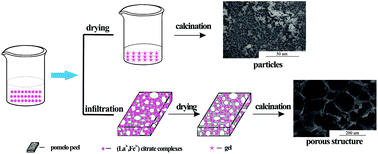Preparation, characterization and catalytic application of hierarchically porous LaFeO3 from a pomelo peel template
Abstract
Hierarchically porous LaFeO3 perovskites are synthesized through a facile process by using pomelo peel as a biotemplate. The samples are characterized by X-ray diffraction (XRD), scanning electron microscopy (SEM), N2 adsorption–desorption analyses, Fourier-transform infrared spectroscopy (FT-IR), thermogravimetric/differential thermal analysis (TG–DTA) and transmission electron microscopy (TEM). The results show that pomelo peel templated LaFeO3 perovskites successfully replicate the structural features of pomelo peel from the macro- to the nanoscale, resulting in a hierarchically porous structure. Moreover, the framework is assembled from plenty of nanoparticles, and there exist a large number of voids between the nanoparticles in the framework. The surface area and average pore diameter of pomelo peel templated-LaFeO3 are 26.7 m2 g−1 and 21 nm, respectively, which are larger than bulk LaFeO3. The catalytic performances of the as-prepared samples for the NO + CO reaction are tested. The templated LaFeO3 exhibits better catalytic activity, with NO conversion achieving 95% at 324 °C and CO conversion achieving 94% at 350 °C. This can be assigned to its larger specific surface area and hierarchically porous structure, which can lead to more active sites and promote the diffusion of reactants in the reaction.


 Please wait while we load your content...
Please wait while we load your content...